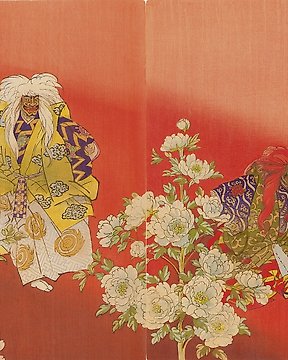
Sekkyō 石橋 - From the series ‘Nōgaku hyakuban’ 能楽百番 – 1921 - Tsukioka Kōgyo 月岡耕漁 (1869-1927) - 日本 - 大正時期(1912-1926)
編號 84490753

編號 84490753

Original woodblock print triptych - Paper - Nakazawa Toshiaki 中沢年章(1864-1921) - "Minamoto no yoshiie"源義家 from "Kyokun rekishi gakai" 教訓歴史画解- Japan - 1898 (Meiji 31)
Good condition, some thinned areas and stains
Utagawa Yoshitora is name ‘Toshiaki-e’ 年章画” in his signature.
Publisher by Hasegawa Sonokichi
A disciple of Yoshitoshi Tsukioka. His family name is Nakazawa and his given name is Entaro. His names are Toshiaki(年章) and Yusai(幽斎).Born as the eldest son of peasants Soho and Riu in Fuse Village, Koma District, Kai Province (now Koigawa, Chuo City, Yamanashi Prefecture). He lost his father when he was 6 years old, and two years later his stepfather Kishichi married and had a younger brother. In 1881, he married his stepfather's niece, but divorced him four years later. After that, he left the household to his younger brother and went to Tokyo to become a disciple of Yoshitoshi Tsukioka.It is not clear why he studied under Yoshitoshi Tsukioka, but Yoshitoshi visited Kofu in 1864 to create curtain paintings for the Kofu Dosojin Festival, and also in Yamanashi Prefecture in 1871 (Meiji 4). is visiting Since he was still young when he visited in the first year of Genji, it is possible that he met Yoshitoshi when he visited in Meiji 4, or that he was introduced to Yoshitoshi in Tokyo by a local painter in Yamanashi.
His first work was 'Aoyama Parade Ground Review Ceremony Gokonozu' (large-format triptych) in 1888, and less than 30 nishiki-e prints have been confirmed until 1906. The breakdown shows the largest number of war paintings related to the Sino-Japanese War. In addition, he is known for paintings of warriors such as 'Yoshitsune's Revival(義経再興記)', which is a series of three large prints, and genre paintings such as 'Nihon Senkei(日本撰景)'.He returned to Yamanashi around 1898, and while moving from place to place within the prefecture, he worked on original paintings for the local people. This is thought to be due to the decline of ukiyo-e after the Sino-Japanese War and the retirement of ukiyo-e artists. Unlike nishiki-e, there are no paintings of social conditions in the handwritten paintings of the nensho, but historical paintings, portraits, paintings of beautiful women, landscape paintings and bird-and-flower paintings with a strong Nanga style have been confirmed, mainly in the local area.